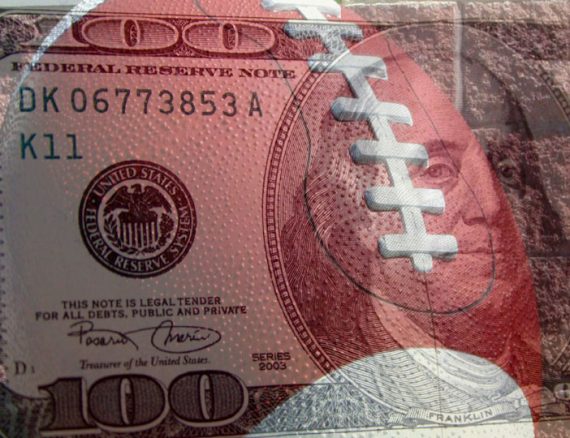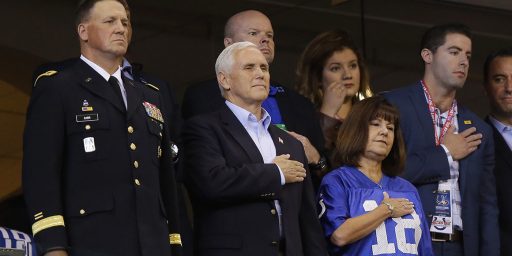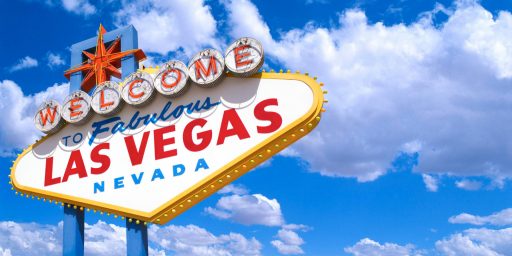Public Financing of Private Sports Stadiums
Ilya Shapiro asks, "If luxury stadiums were hugely profitable, why would the savvy businessmen who own the teams let the politicians in on the windfall?"
Ilya Shapiro asks, “If luxury stadiums were hugely profitable, why would the savvy businessmen who own the teams let the politicians in on the windfall?”
The question, the conclusion of a CATO@Liberty blog post titled, “Public Financing of Vikings Stadium a Bad Deal for Fans, Taxpayers,” is clever but unfair. The argument owners make in this regard is that stadiums create a large amount of revenue for the community that boosts the tax base and that therefore the community should help pay for it.
Now, that argument is questionable at best. As Shapiro and Nick Mosvick note,
Vikings ownership, NFL commissioner Roger GoodellAnd, and local politicians make a typical pitch for the deal: the stadium will attract investment to the area; local establishments will see a rise in game-day sales of $145 million; jobs will be created, including 1,600 in construction worth $300 million ($187,500 per job?!); tax revenues will increase $26 million; property values will rise; and, of course, the perennially underachieving team’s fortunes will improve.
Such arguments are always trotted out for these sweetheart deals, but the evidence regarding the economic effects of publicly financed stadiums consistently tells a different story. For example, Dennis Coates and Brad Humphreys performed an exhaustive studyof sports franchises in 37 cities between 1969 and 1996 and found no measurable impact on per-capita income. The only statistically significant effects were negative ones because revenue gains were overshadowed by opportunity costs that politicians inevitably ignore.
An older study looked at 12 stadium areas between 1958 and 1987 and found that professional sports don’t drive economic growth. A shorter-term study looked at job growth in 46 cities from 1990 to 1994 and found that cities with major league teams grew more slowly. Even worse, taxpayers still service debt on now-demolished stadiums, including the $110 million that New Jersey still owes on the old Meadowlands and the $80 million that Seattle’s King County owes on the Kingdome. And we shouldn’t forget that local governments often employ property-rights-trampling eminent domain to facilitate these money-squandering projects.
These are all fair points, indeed. But neither Governor Mark Dayton nor the Minnesota legislature are unaware of these points. That’s why it took years to get the deal done–and then only after Goodell told state officials that the Vikings were as good as moved to Los Angeles if they didn’t pony up.
Way back in 2004, when the Washington Nationals baseball club was negotiating with the DC government on their new stadium, I wrote a piece for TCS Daily titled “Applying Free Market Logic to an Unfree Market.” I’ll prepend a large chunk of the close here:
Big time sports are not, strictly speaking, a free market. Because there are a limited number of Major League (or NFL or NBA) teams, the owners have unusual leverage. Post columnist and ESPN talk show host Michael Wilbon notes,
“For more than 30 years, D.C. has been a beggar. The District tried to steal other folks’ teams. The city and its representatives lobbied for expansion teams. Baseball team owners used the threat of moving to D.C. as leverage to get shiny new publicly funded stadiums and stay put.”
The last twenty-odd years of the National Football League provide an interesting case study:
- 1982: Oakland Raiders move to Los Angeles
- 1984: Baltimore Colts move to Indianapolis
- 1987: St. Louis Cardinals move to Phoenix
- 1993: Carolina Panthers and Jacksonville Jaguars are awarded NFL franchises for 1995
- 1995: Los Angeles Rams move to St. Louis; Los Angeles Raiders move back to Oakland
- 1996 : Cleveland Browns move to Baltimore
- 1997: Houston Oilers move to Tennessee
- 1998: Cleveland granted franchise for 1999
- 1999: New England Patriots negotiate move to Hartford to force better deal from Foxboro
- 2000: Houston awarded franchise for 2002
- 2004: Indianapolis funds expensive new stadium for Colts
As this cycle of city/stadium roulette illustrates, there is tremendous desire for a professional team. The mere threat of relocation has secured several teams better stadium deals. Several cities — Oakland, Baltimore, St. Louis, Cleveland, and Houston — that declined to pay up to keep their current teams wound up paying even more a few years later to lure other teams or secure an expansion team.
Charlotte and Jacksonville competed with former NFL cities and others who hoped to be elevated to “big league” status to obtain their franchises, and had to provide substantial funding for a state-of-the-art facility to win their bids.
Several teams, including the Minnesota Vikings, Indianapolis Colts, New Orleans Saints, and San Diego Chargers have been rumored to be eyeing a move to Los Angeles if they can secure a better stadium deal.
Just this week, Indianapolis Mayor Bart Peterson announced a half billion dollar stadium deal to keep the Colts in town, stating forthrightly “It’s not my first choice but the alternative in this case is, do you want the Colts to leave?” Granted, the NFL is more popular than MLB these days. On the other hand, a Major League team will play a minimum of 81 home games every year, as contrasted with eight in the NFL.
While libertarians rightly bemoan the notion of forcing taxpayers to subsidize wealthy team owners, they should understand that the market works both ways. If sports leagues have the leverage to demand public financing of stadia as a precondition for moving a franchise to a city, they would be foolish not to use it.
Luring a professional sports team is difficult and generally not economically smart. It is rather galling that the vast majority of a town’s residents who will never attend a game are forced to pay for the privilege of added traffic congestion. Nonetheless, there are plenty of cities out there begging for a team. Public subsidies for arenas are the cost of playing.






Huge boondoggles. Huge.
Baseball – same thing. The Yankees – the richest team in the sport – got NYC to kick in a bunch of money for infrastructure improvement (the team graciously paid for the actual stadium themselves). As if the Yankees are the Yankees without New York! They’re not gonna leave. But politicians just love them some professional sports welfare. Rudy Guliani is basically a parody of a Yankees fan at this point…
I would really love it if there were some rule that net taxation must be uniform for companies within a state. It would end these crazy competitions and races to zero.
Amazon poised to get California sales-tax money — and keep it
Stadiums are a poster child for this kind of thing, but they are by no means alone.
Privately financed AT&T Park in SF sparked a renaissance in China Basin, an area that had been badly blighted. They also built the sucker for about what Citi paid for naming rights to Citi Field.
It’s kind of hard to see publicly finance stadiums as much more than welfare for the 1%. The highlight of GWs business career was the construction of the new Rangers ballpark, which was made possible by a tax increase.
The first problem is when we start talking about a “free market” it’s a term that, on close examination, has no meaning other then what the speaker wants it to mean. A “market” is always regulated in some way or another otherwise it would be nothing more then a free for all with no rules and the winners being whoever can take things by shear force and coercion. The is no such thing as a free market, all markets are regulated to one extent or another. Some more highly then others. Some are regulated by a private organization, the government, or by custom and existing law.
The ability of businesses to hold hostage jobs in exchange for tax subsidies and other favored should be outlawed by constitutional amendment. I know this would never happen but is a travesty that our system of commerce runs on what amounts to bribery.
Here’s the deal:
As long as there are cities who are willing to pay, there is less likelihood that the privately financed deals will occur.
The San Francisco Giants went to the voters 4 times – unsuccessfully – before the ownership group put together their private financing plan. What amazed me is that, this was the 1st privately financed stadium deal since the LA Dodgers did it in 1960. Needless to say, the other owners were not pleased that the Giants did it privately.
Why wouldn’t you take corporate welfare?
It helped Bain make bazillions of dollars.
I think Indianapolis has built up its downtown sports facilities, and attracted the NCAA headquarters, with the idea of becoming the national sports venue. This made them more vulnerable to a move than otherwise. I think the downside to this strategy is that once the construction cranes leave, you’ve developed a lot of tourism/entertainment/hotel jobs that don’t pay particularly well.
If teams are such a big benefit to the city, why depend on the whims of a single owner to keep the team in the area? Why not create some a public team (public in the sense of jointly owned by a broad set of shareholders rather than in the sense of financed via tax dollars) along the lines of the Green Bay Packers?
@ al-Ameda
It’s interesting that both Dodger Stadium and AT&T are both classic ballparks that have been hugely successful – especially when you consider how many crap ballparks have been built (and some demolished) in the 40 odd years between construction of the two parks.
@al-Ameda: After the San Francisco Giants, the Cardinals were the next MLB team to self-finance their new stadium. They made a feint towards moving across the river to Madison, Illinois, but the city didn’t think they were credible to move.
Whatever leverage the teams have, is offset by the fact that succesful franchises aren’t likely to do better somewhere else. Worse-managed franchises like to blame the facilities for their problems. And then there are the NY Yankees . . ..
I ran across some figures that might be of interest:
Should Cities Pay for Sports Facilities? (from 2001)
As James has pointed out: “It is rather galling that the vast majority of a town’s residents who will never attend a game are forced to pay for the privilege of added traffic congestion.” I would suggest that teams don’t have to compete for the city’s residents’ money because the affluent and corporations (and public officials) are essentially subsidized to attend games.
We also need to consider that a significant percentage of the taxpaying public has been priced out of the very stadiums and arenas they are paying for. What’s the message to the average Joe – “you get to pay for it, even if you can’t afford to go to a game there”?
Don’t see any hidden costs for The City in this story. Hope it’s a 3 point shot!
Read more: http://www.sfgate.com/cgi-bin/article.cgi?f=/c/a/2012/05/22/MNP41OK74T.DTL#ixzz1vitLILJy
(How about a thumbs up for reverting back to San Francisco Warriors.)
A few years ago the owner of the Portland Trail Blazers went to the city and said he needed a new venue. The city said fine – build one. We will help get you the land. He did and it’s got something going on most of the time and he’s making big bucks. Now the owner is billionaire Paul Allen with very deep pockets and he built a state of the art house.